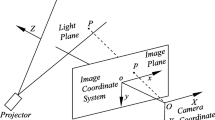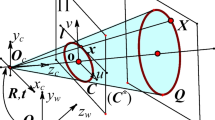Abstract
In this work, we propose several new methods for detecting photographic composites using circles. In particular, we focus on three kinds of scenes: (1) two coplanar circles with the same radius; (2) a single circle with its discriminable center; (3) a single circle with geometric constraints for camera calibration. For two circles’ situation, we first estimate the focal length based on the equality of the sizes of two coplanar circles, and then estimate the normal vector of the world circle plane. Inconsistencies in the angles among the normal vectors (Each circle determines a normal vector) are used as evidence of tampering. On the other hand, for the single circle case, we warp the circle to make metric measurement. To demonstrate the effectiveness of the approach, we present results for synthetic and visually plausible composite images.
Similar content being viewed by others
Explore related subjects
Discover the latest articles and news from researchers in related subjects, suggested using machine learning.References
Huang P, Tang Z M, Chen C-K, Cheng X T. Nearest-neighbor classifier motivated marginal discriminant projections for face recognition. Frontiers of Computer Science in China, 2011, 5(4): 419–428
Zhao F, Jiao L C, Liu H Q. Fuzzy c-means clustering with non local spatial information for noisy image segmentation. Frontiers of Computer Science in China, 2011, 5(1): 45–56
Chen Z Y, Fan W, Xiong Z, Zhang P G, Luo L X. Visual data security and management for smart cities. Frontiers of Computer Science in China, 2010, 4(3): 386–393
Farid H. A survey of image forgery detection. IEEE Signal Processing Magazine, 2009, 26(2): 16–25
Dirik A E, Sencar H T, Memon N. Digital single lens reflex camera identification from traces of sensor dust. IEEE Transactions on Information Forensics and Security, 2008, 3(3): 539–552
Swaminathan A, Wu M, Liu K J R. Digital image forensics via intrinsic fingerprints. IEEE Transactions on Information Forensics and Security, 2008, 3(1): 101–117
Cox I J, Miller M L, Bloom J A. Digital watermarking. Morgan Kaufmann Publishers, 2002
Liu H, Rao J, Yao X. Feature based watermarking scheme for image authentication. In: Proceedings of IEEE International Conference on Multimedia & Expo. 2008, 229–232
Fridrich J, Soukal D, Lukáš J. Detection of copy-move forgery in digital images. In: Proceedings of Digital Forensic Research Workshop, Cleveland, OH. 2003
Ngand T T, Chang S F. A model for image splicing. In: Proceedings of IEEE International Conference on Image Processing. 2004, 1169–1172
Popescu A C, Farid H. Exposing digital forgeries by detecting traces of re-sampling. IEEE Signal Processing Magazine, 2005, 53(2): 758–767
Bayram S, Avcibas I, Sankur B, Memon N. Image manipulation detection with binary similarity measures. In: Proceedings of European Signal Processing Conference. 2005
Luo W, Huang J, Qiu G. JPEG error analysis and its applications to digital image forensics. IEEE Transactions on Information Forensics and Security, 2010, 5(3): 480–491
Farid H. Digital image ballistics from JPEG quantization: a follow up study. Department of Computer Science, Dartmouth College, 2008
He J, Lin Z, Wang L, Tang X. Detecting doctored jpeg images via DCT coefficient analysis. In: Proceedings of European Conference on Computer Vision. 2006, 423–435
Farid H. Exposing digital forgeries from JPEG ghosts. IEEE Transactions on Information Forensics and Security, 2009, 1(4): 154–160
Hsu Y F, Chang S F. Image splicing detection using camera response function consistency and automatic segmentation. In: Proceedings of IEEE International Conference on Multimedia and Expo. 2007, 28–31
Lukáš J, Fridrich J, Goljan M. Detecting digital image forgeries using sensor pattern noise. Society of Photo-Optical Instrumentation Engineers Conference Series, 2006, 6072: 362–372
Popescu A C, Farid H. Exposing digital forgeries in color filter array interpolated images. IEEE Transactions on Signal Processing, 2005, 53(10): 3948–3959
Johnson M K, Farid H. Exposing digital forgeries through chromatic aberration. In: Proceedings of ACM Multimedia and Security Workshop, Geneva, Switzerland. 2006
Zhang W, Cao X, Zhang J, Zhu J, Wang P. Detecting photographic composites using shadows. In: Proceedings of IEEE International Conference on Multimedia & Expo. 2009, 1042–1045
Liu Q G, Cao X C, Deng C, Guo X J. Identifying image composites through shadow matte consistency. IEEE Transactions on Information Forensics and Security, 2010, 6(3–2): 1111–1122
Johnson M K, Farid H. Exposing digital forgeries by detecting inconsistencies in lighting. In: Proceedings of ACM Multimedia and Security Workshop. 2005, 1–9
Criminisi A, Reid I, Zisserman A. Single view metrology. International Journal of Computer Vision, 2000, 40(2): 123–148
Johnson M K, Farid H. Detecting photographic composites of people. In: Proceedings of the 6th International Workshop on Digital Watermarking. 2007
Kee E, Farid H. Detecting photographic composites of famous people. Department of Computer Science, Dartmouth College, 2009
Wang W, Farid H. Detecting re-projected video. In: Proceedings of the 10th International Workshop on Information Hiding. 2008
Johnson M K, Farid H. Metric measurements on a plane from a single image. Department of Computer Science, Dartmouth College, 2006
Conotter V, Boato G, Farid H. Detecting photo manipulation on signs and bill boards. In: Proceedings of the 17th IEEE International Conference on Image Processing. 2010, 1741–1744
Zhang W, Cao X, Feng Z, Zhang J, Wang P. Detecting photographic composites using two-view geometrical constraints. In: Proceedings of IEEE International Conference on Multimedia & Expo. 2009, 1078–1081
Zhang W, Cao X, Qu Y, Hou Y, Zhao H, Zhang C. Detecting and extracting the photo composites using planar homography and graph cut. IEEE Transactions on Information Forensics and Security, 2010, 5(2): 544–555
Deng Z P, Jia K B, Chan Y-L, Fu C-H, Siu W-C. Fast motion and disparity estimation for multiview video coding. Frontiers of Computer Science in China, 2010, 4(4): 571–579
Wu H, Chen Q, Wada T. Visual direction estimation from a monocular image. IEICE Transactions on Information and Systems, 2005, E88-D(10): 2277–2285
Hartley R, Zisserman A. Multiple View Geometry in Computer Vision. Cambridge University Press, 2004
Zhang Y, Liu Y. The projective equation of a circle and its application in camera calibration. In: Proceedings of the 19th International Conference on Pattern Recognition. 2008, 1–4
Wang G, Wu J, Ji Z. Single view based pose estimation from circle or parallel lines. Pattern Recognition Letters, 2008, 29(7): 977–985
Fitzgibbon A, Pilu M, Fisher R B. Direct least square fitting of ellipses. IEEE Transactions on Pattern Analysis and Machine Intelli gence, 1999, 21(5): 476–480
Zhang Z. A flexible new technique for camera calibration. IEEE Transactions Pattern Analysis and Machine Intelligence, 2000, 22(11): 1330–1334
Author information
Authors and Affiliations
Corresponding author
Additional information
Shuyi Zhu received the BE from the College of Mathematics and Computer Science, Hebei University, China, in 2008. She worked as a research assistant in Computer Vision Laboratory from April 2009 to January 2012. Her research interests lie in the computer vision field, covering multimedia forensics, multiple view geometry, and 3D reconstruction.
Xiaochun Cao received the BE and ME both in Computer Science from Beihang University, China. He received the PhD in Computer Science from the University of Central Florida, Orlando, USA, with his dissertation nominated for the university-level award for outstanding dissertation.
After graduation, he spent about three years at ObjectVideo Inc. as a research scientist. Since August 2008, he has been with Tianjin University, China, where he is currently a professor of computer science. He has authored and coauthored over 50 peer-reviewed journal and conference papers, and has been in the organizing and the technical committees of several international colloquia.
In 2004 and 2010, Dr. Cao was the recipients of the Piero Zamperoni best student paper award at the International Conference on Pattern Recognition.
Handong Zhao received the BE from the School of Computer Science and Technology, Tianjin University, China, in 2010.
He is currently a second-year graduate student with the School of Computer Science and Technology, Tianjin University, China. He has been working as a research assistant in Computer Vision Laboratory since 2010. His research interests lie in the computer vision field, covering multimedia forensics, object segmentation, and image processing.
Rights and permissions
About this article
Cite this article
Zhu, S., Cao, X. & Zhao, H. Photographic composite detection using circles. Front. Comput. Sci. 6, 741–755 (2012). https://doi.org/10.1007/s11704-012-1248-2
Received:
Accepted:
Published:
Issue Date:
DOI: https://doi.org/10.1007/s11704-012-1248-2




